"Is This Legal?" Feb 2
meet the company that powers silicon valley's race- and gender-based hiring goals
River PageReader, hi, it’s the 24th issue of the White Pill, and it’s easily our best issue yet. This one has a lead story: an interview with the legendary Robert Zubrin, founder of Mars Society, prolific space and science writer, and preeminent aerospace engineer. We discuss farming on Mars, and how to get rich off of Martian technology. After the lead story, it’s your White Pill standard fare: NASA’s first asteroid sample return mission, using neutrinos to predict supernovas, a look at Axiom space station crew accommodations, facial recognition for your pets, the world’s first robot factory, eVTOL airport shuttles, artificial wombs, your daily reason to think about ancient Rome, and way more.
---
Interview with Robert Zubrin
While there’s significant investment and R&D into terrestrial biotech applications, Martian biotech is underserved, and could doubly produce terrestrial benefits. These benefits could translate into cash flow, which the Mars Technology Institute (MTI) — a Mars Society project “whose purpose will be to develop the technologies needed to settle” Mars — could funnel back into more Martian research, and ultimately, Martian expeditions, Mars Society founder and prolific Mars author Robert Zubrin told me over Zoom in early September. In other words, the MTI has a business model to prove: can it develop Martian technology here, spin it into products or license the intellectual property (IP), and become a financial powerhouse?
“We want to create MTI as an engine of invention to enable Martian settlements, and therefore an engine of finance to enable Martian settlements. And also, to prove the validity of the business model,” he said. “In addition to having a staff of professional researchers, we’re going to take proposals from people who are willing to do research on their own time, if, for instance, we pay for the materials. We’ll fund the proposals that are the most meritorious in terms of their potential impact on Mars, the potential value of IP they could produce, and the credibility of the teams proposing them. This is going to greatly amplify what we do. It will increase our productivity by an order of magnitude. And the MTI will own the IP.”
The first interview I did for the White Pill was with Delian Asparhouv, co-founder of Varda Space Industries. I gave the interview while the results of their first in-space drug manufacturing run were being transmitted from low-Earth orbit to Earth. Going into the conversation, my intention had been to prompt Delian about humanity’s far future in space, because I thought that would make for fun reading. We ended up talking about the viability of space-based business models almost the entire time, and I sensed that he was honed in on the urgency of unlocking demand for cislunar activity with a value framework that would make its investors rich. Space will necessarily be the domain of entrepreneurs, Delian said — commerce will be the subject of space. There’s no other realistic way to settle other planets.
Zubrin thinks MTI could make its investors rich. It could license its IP to other companies and collect royalties. It could invite investors to fund spin-off companies based on MTI inventions for equity. Maybe, Zubrin thinks, MTI could end up with an empire of companies based around the inventions MTI produces. “Ultimately, if we’re truly successful, some of these inventions could be so productive as to make the MTI a financial powerhouse, which will enable us to finance the settlement of Mars.”
Obviously, anything the MTI comes up with needs to be a solution for both a Martian problem and a terrestrial problem — just one or the other doesn’t work. The demand needs to be on both planets. Therefore, at the top of Zubrin’s priority stack is updating food’s relationship to energy. “Vegetarians always talk about how inefficient meat is, because you take a given amount of corn, and you feed it to a cow, and maybe you only get a small percent of the caloric value that was in the corn out in the form of meat,” he said. “So by going from vegetable to meat, you’re cutting the value by factors. But the greatest inefficiency in that process isn’t going from vegetable to animal, it’s going from sunlight to vegetable.
“Take an Iowa corn field, which is among the most productive agriculture ever practiced. If you take the solar energy hitting that cornfield, and compare it to the energy coming out in the form of corn, it’s 0.2 percent efficient. That’s how efficient the most productive agriculture in the world is.

Not happening on Mars | Image created with Midjourney by @zekedup
“An Iowa corn field produces 12 tons per hectare, per year. That boils down to 30 kg per day of corn. So if you fed people with nothing but a kilogram of corn a day, which would be a pretty lousy diet, that means a hectare could support 30 people. If we make the diet more interesting, with some fruits and a little bit of meat, let’s say the hectare would support 20 people. That means if you wanted to have a 20,000-person Martian colony — the size of a pretty small town — that’s 1,000 hectares. 10 square kilometers. Over six square miles. That’s huge for a small town. And for a million people — a medium-sized city — you’d need 50,000 hectares. This is unthinkable on Mars. And that’s assuming you have the same productivity in Martian sunlight as you do on Earth. But Martian sunlight is only half as strong as Earth sunlight!”
If it’s not clear yet, endless Iowa-style cornfields stretching to the Martian horizon aren’t on the menu, at least in our lifetimes. It’s not just that the planet gets under half the amount of sunlight that Earth does. Because Mars’ atmospheric pressure is less than a percent of Earth’s, liquid water would immediately boil away when exposed to the Martian air. The Martian atmosphere is composed mostly of carbon dioxide, with virtually no oxygen, and plants require oxygen for respiration. During daytime, temperatures at the Martian equator can reach up to around 70°F (20°C). However, they can plummet sharply once the sun sets, dropping to values as low as -80°F (-62°C) during the night, which would be fatal to any crop.
But Mars will have to produce its own food. If it uses agriculture, it will have to be in artificially lit underground tunnels, or pressurized greenhouses on the surface, which will severely restrict arable acreage. Like American agronomist Norman Borlaug, who developed a high yield wheat cultivar that wasn’t sensitive to day length and helped herald the Green Revolution, Martian technologists are going to have to innovate to create ultra-productive agriculture — or other highly efficient ways of producing food. This technology could be exported to Earth, where it could, for example, allow us to use half the farmland to produce the same amount of food.

More likely to happen on Mars | Image created with Midjourney by @zekedup
Zubrin says technology export will in fact be Mars’ main export. Mars IP will pay for its Earth imports. “In 18th and 19th century America, you had a technologically adept population in a free country interacting with a frontier, which forced them to innovate in a situation where they were free to innovate, so that’s what they did,” he said. “Mars is going to be that way as well, but to a much greater degree. It will be an even more technologically adept population in a much more challenging frontier environment. So Martians are going to invent. And those inventions are going to benefit the Earth, and they’re going to pay for the imports to Mars.”
Of course, we’re not on Mars yet, which brings us back to the MTI, which of this moment is set up as a 501(c)(3). But Zubrin is setting up a C-Corp called the Mars Technology Lab (MTL), which will allow investors to take equity in MTI IP. If humanity is lucky, those investors will become rich; if they do, that would mean we’re at least one step closer to being interplanetary. You don’t even need to care about Mars for that to be a good thing. “There’s nothing that would be more beneficial to Earth than a new branch of civilization engaged in productive invention,” Zubrin said.
---
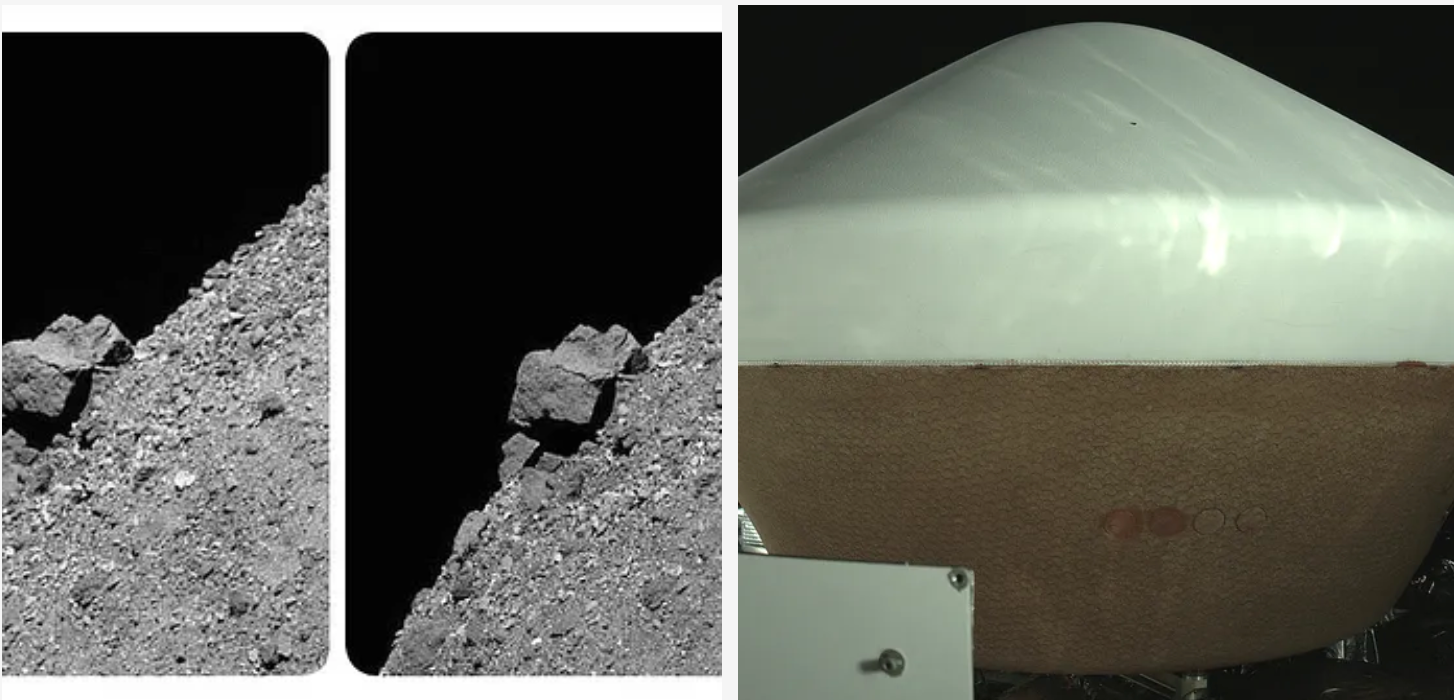
70-foot (52-meter) boulder that juts from asteroid Bennu’s southern hemisphere | the Sample Return Capsule in space
Asteroid sample return. Tomorrow, OSIRIS-REx, NASA's first asteroid sample return mission, will deliver about half a pound of material — more than previous asteroid sampling missions — from the surface of asteroid Bennu that it retrieved in October 2020. It'll be a pretty epic delivery. The main craft will not even slow down, instead jettisoning the sample capsule about 63,000 miles above the Earth’s surface. After re-entering the atmosphere, the return capsule will land via parachute in the Utah’s West Desert. The main craft will continue on a trajectory toward the asteroid Apophis, which recently flew by Earth, and go into orbit around it, studying the effects of the flyby. (SciTechDaily)

SN 1006 supernova remnant, located about 7,100 light-years from Earth
Early warning system for spotting supernovas. A new observatory called the Jiangmen Underground Neutrino Observatory (JUNO) should be able to recognize when a star goes supernova before optical telescopes see the characteristic burst of light. That’s because in the most common type of supernova, called a core-collapse or Type II supernova, the neutrinos actually escape the star’s collapsing core almost immediately, whereas the massive burst of light isn’t produced until the actual explosion, and is then delayed slightly by the rest of the star before it streams off into space. Because neutrinos move almost light speed, they should reach JUNO with enough time that it can alert other observatories and tell them where to look. This also means that if Betelgeuse (642.5 light years away) blows up anytime soon, we should have time to make sure everyone is watching before the light show begins. (Universe Today)
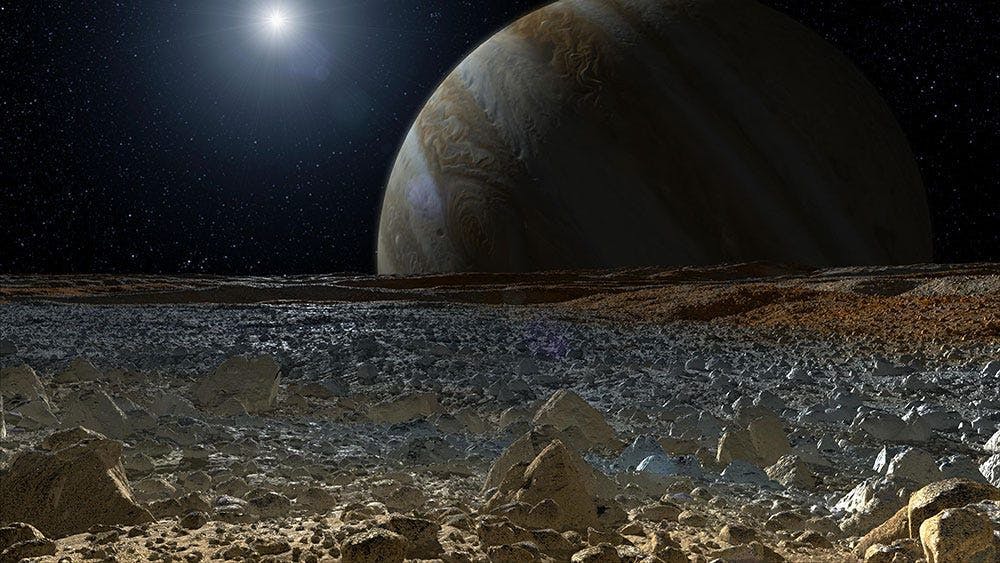
Simulated View from Europa's Surface | Image from NASA
Carbon dioxide detected on the surface of Jupiter’s moon Europa — implies a potentially habitable environment. JWST found carbon dioxide ice on the surface of Europa, one of the four large moons of Jupiter. Europa has an extremely thin atmosphere, composed primarily of molecular oxygen (O₂), but it’s so tenuous it would be considered a vacuum by Earth standards, meaning that any liquid on the surface would pretty much instantly boil away. But a layer of ice that could be several kilometers thick coats the moon’s surface, and acts as a barrier to a salty, subsurface ocean below it. Until now it wasn’t known whether carbon — essential for life as we know it — was present in the subsurface ocean. But because the CO2 was detected at a location on Europa where ocean/ice exchange is thought to occur, and because CO2 isn’t stable for long periods on the surface, this deposition is thought to have occurred in the fairly recent past, and is strong evidence that there is carbon present in the subsurface ocean. (Twitter/X) (ESA)
More:

Lower tendrils of a sprite (red lightning) | Sun filament shaped like a question mark
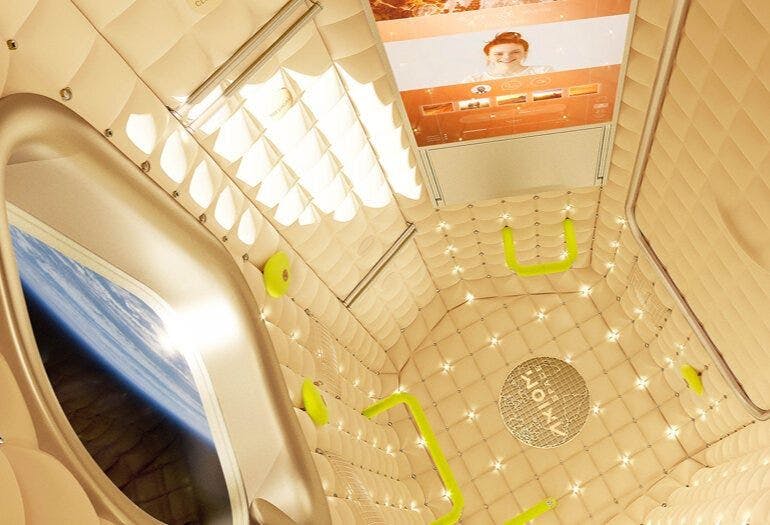
Axiom space station crew accommodations — “nest-like comfort complete with unobstructed views of our home planet.” Check out progress of the company’s space station construction.
---
The White Pill Investment Index tracks investments in companies developing interesting, exciting, forward-thinking products. For last week’s deals, check out last week’s White Pill. Deals are sourced from Pitchbook.
---
Robot factory. The world’s first factory for building humanoid robots has been built by Agility Robotics in Oregon, USA, with the capacity to produce at least 10,000 robots per year. Set to open later this year, "the opening of our factory marks a pivotal moment in the history of robotics: the beginning of the mass production of commercial humanoid robots.” The robot Agility will be producing there is called Digit, a bipedal robot that can move totes and packages, and will eventually be able to unload trailers and do last-mile delivery services. (Future Timeline)

From jobyaviation.com
Electric air taxi factory coming to Ohio. Joby Aviation, who is partnering with Delta to launch an airport service to LAX, selected Dayton Ohio for the site of its electric vertical takeoff and landing (eVTOL) air taxi factory. With plans to start selling rides — in the manner of a taxi or private car service — as soon as 2025, Joby will invest $500 million in the site, which it says will provide up to 2,000 jobs. Their air taxi will take off and land vertically, and carry four passengers and a pilot — it’s all-electric and can travel at up to 200 mph with a 100 mile range. (TechCrunch)
More:
---
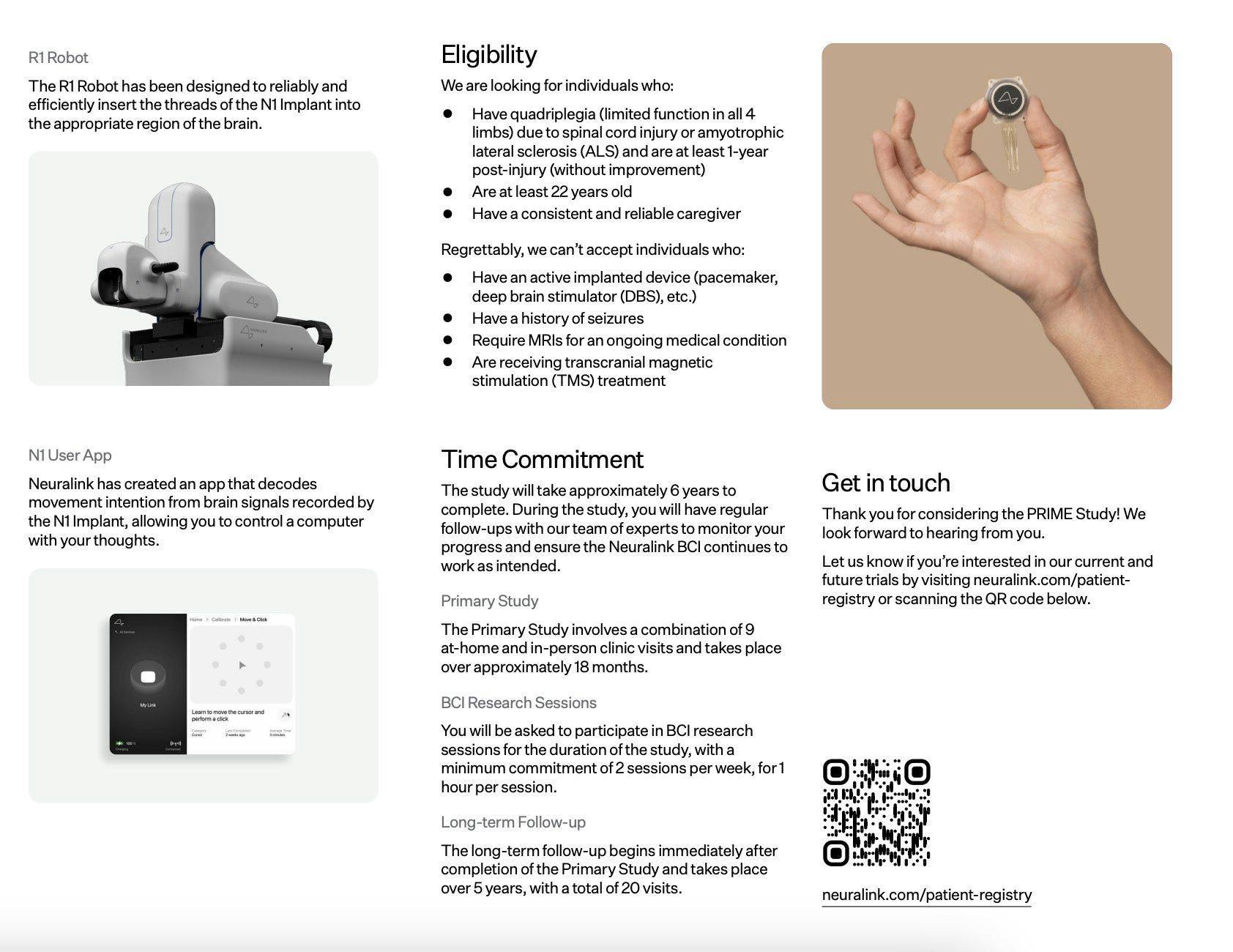
From the trial brochure
Neuralink opens clinical trial. After some pretty impressive results with monkeys, Neuralink has received approval to start testing in humans. This first trial is open to people with amyotrophic lateral sclerosis or quadriplegia from spinal cord injury. The study’s goal is for their wireless brain computer interface to enable “people with paralysis to control external devices with their thoughts.” If this initial goal is achieved, it will give study participants “the ability to control a computer cursor or keyboard using their thoughts alone.” Founder Elon Musk said about the trial that these are only the first steps, and that “This ultimately has the potential to restore full body movement” to paralyzed individuals. (Twitter/X) (Twitter/X) (Neuralink)
Inverse vaccine could stop autoimmune diseases. A new type of vaccine, dubbed an “inverse vaccine,” has showed complete effectiveness in shutting down autoimmune disease expression, where a person’s own immune system erroneously attacks their healthy tissues (e.g., multiple sclerosis, type 1 diabetes, or rheumatoid arthritis) in mice and non-human primates. The vaccine works by mimicking a “do not attack” label that our livers give to old, broken down bits of our cells that have died and need to be recycled. It consists of an antigen — something that sets the immune system off — and “a molecule resembling a fragment of an aged cell that the liver would recognize as friend, rather than foe.” The new approach is called an inverse vaccine because “Rather than rev up immunity as with a vaccine, we can tamp it down in a very specific way with an inverse vaccine.” This would be a huge improvement over current treatment for autoimmune diseases, which weaken the entire immune system, leaving the patient open to infections and cancer. Human safety trials are happening now, and we’re cheering from the sidelines. (The University of Chicago)
More:
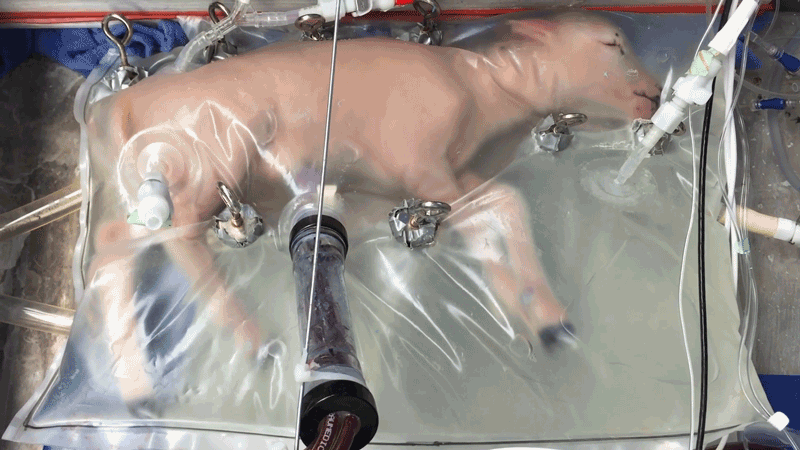
Preterm lamb in an artificial womb
---


Touch grass this weekend.
-Brandon Gorrell
0 free articles left